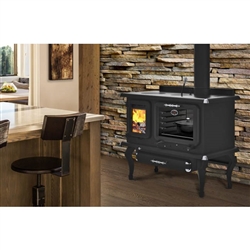Thank you all for the replies.
EbS-P, I can see it being tricky at holidays, but for the most part it sounds like we can get by just fine with this size oven.
begreen, do you have a brand or model that you recommend for beginners, or that several people have reported using on this forum? As a new user, it might be better to start with a stove that people here have lots of experience with. For summer cooking, we have an electric oven.
SpaceBus, is the limited use because it's simply too hot (uncomfortable home temp) to operate? In the shoulder seasons, do you find you're able to extend your cookstove usage by cooking very early, or later at night?
That is exactly what I do in the shoulder season, but cookstoves in general won't put the same amount of heat into the house no matter how high the stated combustion efficiency is. Both of my wood burning stoves are rated at the same output, but the cookstove has a larger firebox and lower combustion efficiency. The cookstove also has a lot of convective surfaces compared to the pure radiant heat offered by my free standing stove. All this is to say a cookstove offers a much "softer" heat compared to a freestanding stove, which is good because you have to stand next to it. Most of the heat is lost to the oven and cooktop, with a bit escaping into the room and up the flue. It's a cool foggy day today, so I could probably light the stove if I wanted to, but I'm ready for a break from burning. Our cookstove is tied into our domestic hot water, which helps reduce the electric bill significantly when burning.
What are your criteria for the cook stove? When I chose the Tim Sistem North it was mainly about the clearances and DHW coil, but at the time it was also offered with a glass cook top which also helped make up my mind. I would buy this stove again, but there are others that I liked more but needed more clearance to combustibles. With proper shielding my North can be installed almost flush. I'm also a big fan of the Elmira Fireview, Heco stoves, the Hearthstone Deva 100, and Esse stoves. It's hard to find a huge oven on a wood burning cookstove, and many stoves with large ovens also call for a large house.
Perhaps you could include a floor plan of where you are thinking to install the stoves. Some details about the rest of the house, like floor plan, average temperature, insulation, etc. would also be useful.
For what it's worth, I loathe using my electric stove compared to my wood burning stove. The wood cooker is simply a joy to use and somehow harder to burn stuff despite higher average surface temperature. The oven is especially nice and I rarely, if ever, burn anything. Last fall I forgot about a pumpkin pie that was finishing off as the fire died down, and even though the oven was above 400f for several hours, with the slowly declining temperature and sealed nature (no water loss when the door is closed) the pie came out perfect. People say there is a steep learning curve to cooking with wood, but I found the opposite to be true. I've also worked quite a bit as a grill/line cook, so I'm used to a massive, always hot cooking surface.




